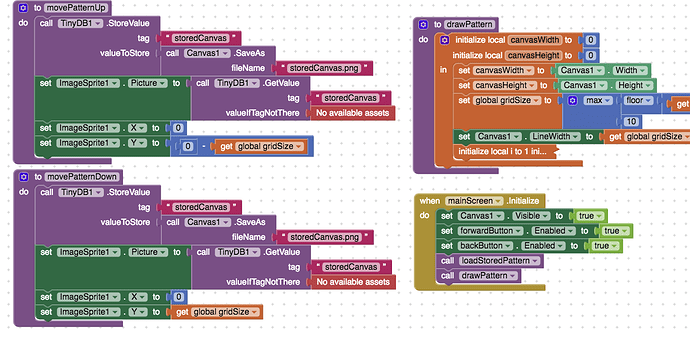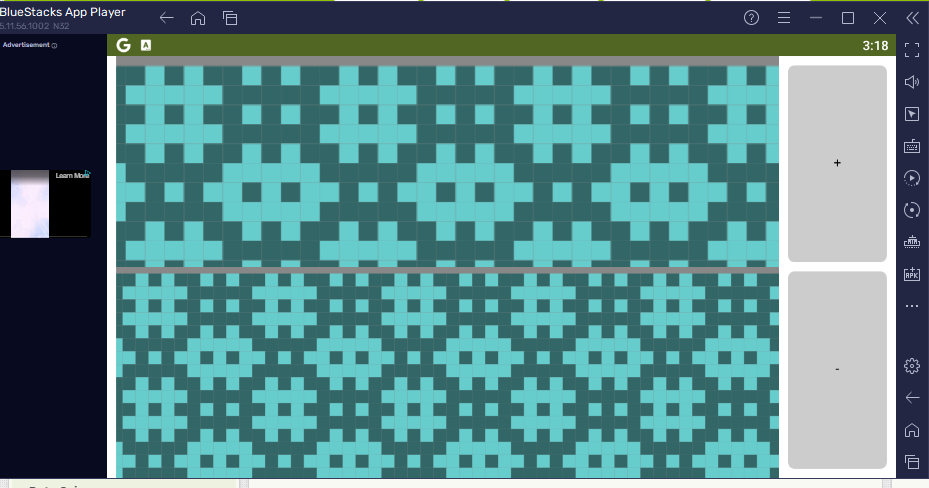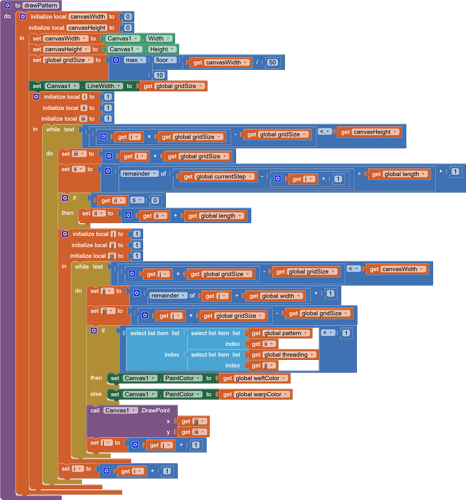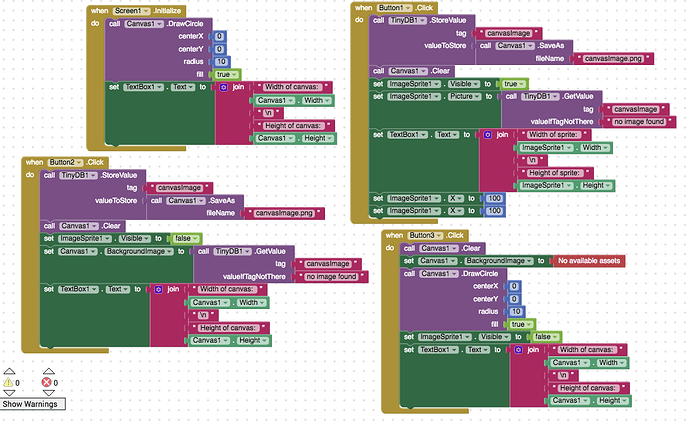It comes from calculating the values of all pixels and use drawpoint. I can redo the drawing, it just takes way too much time.
this is first time draw ?
what about show us you clocks?
You could draw on one canvas, save it to a file, then load it into a sprite moving over another (or even the same?) canvas.
Another idea:
Canvases can be bigger than the space allotted to them, to allow sprites more room at the edges.
Can variable width labels be used as padding for an accordion motion?
I am trying to implement the "save canvas" and "load as sprite approach", but I have some questions.
I attach here what I have so far and here are the relevant blocks.
Here are my questions.
-
When I run the app and press either the + or the - button, the save is successful, the sprite is loaded in the other canvas, but as far as I can tell, it is put in the 0,0 position, not at the position that I specify. What am I doing wrong?
-
Also, the first canvas is cleared as soon as I save it as an image. Is this the normal behaviour? This is not really important, because I will draw back to the original canvas, I am just curious.
-
In the companion, when I move from the start screen to the other screen (and change the orientation), the dimensions of the canvas are not read correctly and in the companion the original drawing does not have 1:1 scale. Squares are presented as rectangles. When I install the app, it looks OK, but nevertheless, I am curious what is happening in companion.
Here is the aia file.
movePatternTrial.aia (213.9 KB)
Perhaps you need to put your canvas inside an arrangement ?
The extra Arrangement shell around each Canvas makes a difference.
movePatternTrial (1).aia (214.1 KB)
This works around the Canvas - Save bug.
I'm not sure if this answers your movement request, though.
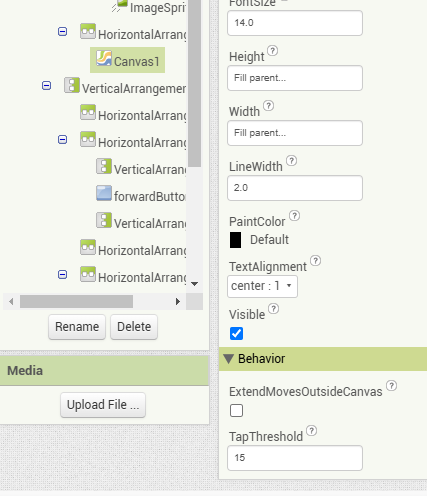
You need to allow sprites to extend outside the Canvas.
See the bottom of the Canvas attributes in the Designer.
movePatternTrial (2).aia (214.1 KB)
Yes, I can see what part of my problem was, and it does copy the image of the canvas to the other canvas. I still don't understand a few things though.
- Why is the sprite copied at (0,0) instead of the specified location?
- Why is the sprite enlarged? I even tried to move the sprite to canvas 1 (to overwrite what is there) and even there it did not copy in the original size.
I made some modifications:
- I copied the sprite back to canvas 1 (so canvas 2 is not used in this version).
- I set the size of the sprite to match the canvas size.
- I cleared the canvas before setting the sprite image.
If I repeatedly click on the buttons, strange things happen. The image in the canvas is changing, but in a strange way.
- Is it possible, that TinyDB is trying to read back the image before it is completely stored?
- Is it possible that this behaviour is the consequence of incorrect canvas height and width reading (because of the change in orientation of the screens)?
movePatternTrial_2.aia (17.4 KB)
TinyDb only stores the file name. That's an all or nothing event, though the Canvas file save sounds like it should not be depended on to be synchronous. Unfortunately, I do not know of any event to catch completion of that operation.
Yes, the Canvas Height and Width need time to settle.
Try to avoid this by coding value functions instead of global variables for various sizes, to get fresher data.
A Sprite might change size in response to the attributes of its Picture. You might try resetting the Sprite's Height and Width in proportion to an enclosing Arrangement's sizes. This would make a difference if the Canvas were larger than the enclosing Arrangement but centered in it. This is a bit of a stunt.
Are you getting a rectangle from each DrawPoint call?
If not, a fat DrawLine should give you a redraw speedup.
P.S. I was surprised to learn that the DrawPoint block actually draws a square with size equal to Canvas.LineWidth. So DrawLine would not provide any speedup.
Yes, I am indeed getting a square for drawpoint.
I still have a problem with the size and positioning of the sprite.
I made a simpler experiment which shows that the canvas is saved as it should be and read back correctly as the background of the canvas (even with empty canvas background).
However, it also shows that when the image is read back as a sprite, it doubles the size and the sprite is not put in the position specified.
Is there anything I can do?
- How is the size of the sprite determined? I would have thought that if it is set to automatic, then it inherits the size of its image.
- Is it possible that even though moving out of the screen is enabled, the system does not like to put a sprite down if it is not completely in the canvas? When I read the text next to the tickbox that allows moves outside canvas, it says that this option is only there for backwards compatibility. This suspicion is confirmed by adding manual sizing of the sprite to my code. If I set the size to 100 or less, then it is moved correctly to position (100,100) on the 200 by 200 canvas. If the size is set to 200 or above, the sprite is moved to the 0 position. If the size is set to something between 100 and 200, then is moved to a position where the full sprite fits in the canvas. For example, if the size is 130 by 130, then it is moved to position (70,70) instead of the specified (100,100).
movePatternTrial_4.aia (3.9 KB)
ps:
I did not find an option to set the size of a sprite as a proportion. In the designer it is either automatic or fill parent or fixed pixel size.
(post deleted by author)
I am reading the procedure to draw a pattern to see if it can be speeded up to avoid this wierdness.
Does it advance pixel by pixel, or square by square?
Square by square should be faster by a factor of square size ^2
I am also toying the idea that it might be possible to draw an entire row of the canvas as a single polygon shaped like a linear string of square beads, irregularly spaced.
But I have not yet figured out how you map your two matrixes into rows and columns.
I am doing it square by square. It takes a few seconds, so it is not that bad, but it would be better to have an almost instantaneous change. I guess, I will have to learn to create a dedicated extension.
I was also looking at the TaifunImage extension, but it is also problematic for me. There, too, the size of an image depends on where it loads it to, not how it is stored (or at least I could not yet figure out a way of forcing the size). That extension has a crop tool, which I could use to crop the image of the sprite before I place it on the canvas.
I also looked into the canvasLayer extension (it has a tool to copy part of a canvas to another layer), but I could not find a documentation for it , so it will take some time to figure out what part I need (it has a lot of tools).
To be honest, I am a bit surprised that there is no bitmap handling for images. That is how images are stored, it is a 2D array, it would be easy to manipulate that array to do the shift.
I did an experiment generating SVG graphics on a Webview from text a while back, with animation, no extensions.
I can search after breakfast.
I have not thought about the webview. This is an interesting idea. SVG is indeed an option (if you could find your experiment, I would be interested to see it) or I can also try to use javascript to generate the image.
